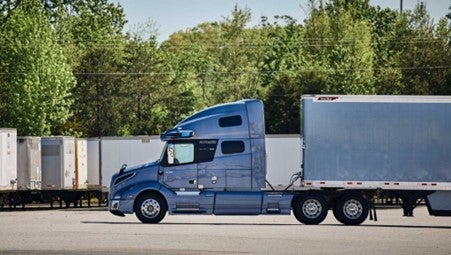
Swedish multinational OEM, Volvo Trucks, currently has two locations across the US reported to be struggling to replicate the high engagement of in-person training in a virtual setting. Volvo reported that virtual training lacked interaction, hindering connection and engagement.
To assist with these setbacks, Class Technologies, a company specialising in online learning and virtual instructor-led training, enhances user experiences and provides centralised access to content and analytics. Class says it has provided a holistic approach for Volvo that enabled a better learning experience and outcomes.

Discover B2B Marketing That Performs
Combine business intelligence and editorial excellence to reach engaged professionals across 36 leading media platforms.
Some key findings from Class’s training shows that teams were more engaged by using polls, whiteboards, and reactions to create an interactive experience. The training also saves time and improves efficiency, enabling Volvo employees to revisit training recordings as if they were in a live session.
We spoke to Michael Chasen, Class CEO and co-founder, and Scott Behe, Volvo Trucks senior manager, training operations, to learn more about working with Volvo and what it means for the Volvo team.
Just Auto (JA): How did the two companies come to be working together?
Michael Chasen (MC): At Class, we’ve always believed that the best learning experiences, whether in-person or virtual, should be engaging, interactive, and effective. Volvo Trucks North America (VTNA) shares that same commitment to delivering high-quality training, particularly for their dealers and technicians, who rely on continuous education to stay ahead in the industry.

When Volvo first approached us, they were looking for a way to take their in-person training programs and deliver them virtually without losing the hands-on, collaborative aspects that make their sessions so effective. They didn’t want a standard webinar-style experience where learners passively absorb information; they wanted something that felt as close to in-person as possible, where instructors could interact naturally with participants, foster discussions, and create real engagement.
By partnering together, we’ve been able to take Volvo’s robust training curriculum and enhance it with technology that makes learning in a virtual classroom feel just as dynamic as an in-person session. It’s a collaboration that has allowed Volvo to expand access to their training while maintaining—and even improving—their ability to connect with learners in meaningful ways.
Which areas were Volvo struggling with when it came to virtual training?
MC: Like many organisations that shifted to virtual learning, Volvo faced some fundamental challenges when it came to engagement, connection, and hands-on interaction. They had spent years perfecting their in-person training programs, and when they moved online, they found that traditional web conferencing tools simply weren’t built to support the way they taught.
One of their biggest hurdles was engagement. Their in-person training sessions are highly interactive, with a lot of back-and-forth between instructors and learners. But in a typical virtual setting, that natural dialogue can be difficult to maintain. Instructors often found themselves speaking into a void, unsure if participants were following along or truly engaged.
Another challenge was replicating hands-on learning. Volvo’s training programs often involve real-world problem-solving and technical demonstrations—things that don’t translate well to a standard video call. They needed a way to recreate that same level of interactivity so learners could practice skills, collaborate, and ask questions in real-time.
They also needed a way to measure engagement and track course effectiveness. In a physical classroom, an instructor can easily pick up on visual and verbal cues—who’s engaged, who’s struggling, who needs more support. But in a virtual setting, those insights are harder to capture. Volvo wanted a data-driven way to track participation, ensure their training was having the desired impact, and make real-time adjustments to keep learners on track.
Finally, there was the issue of personal connection. In an in-person setting, trainers and learners develop relationships. They read body language, they engage inside conversations, and they build rapport. Volvo wanted to bring that same human element into their virtual training so that instructors and participants felt truly connected—not just like faces on a screen.
How is the solution offered by Class assisting Volvo with their virtual training?
What makes Class different is that we don’t just bring training online—we enhance it. With Volvo, we’ve helped transform their virtual training environment by integrating interactive tools that make learning more dynamic, engaging, and personal.
One of the ways we’ve done this is by providing instructors with real-time engagement tools. With features like live polling, reactions, breakout rooms, and whiteboards, Volvo trainers can see exactly how engaged their learners are at any moment. They can encourage participation in ways that go far beyond a simple video call, making training feel much more like an interactive classroom experience.
We’ve also helped them replicate hands-on learning in a virtual space. For example, they use the whiteboard feature for exercises that were traditionally done in-person. One instructor had participants write down their years of sales experience during a session—something so simple, yet it immediately fostered discussion, interaction, and shared learning. That’s the kind of engagement that keeps people tuned in and actively involved.
Another major improvement has been real-time engagement tracking and analytics. With Class’s Learner Engagement Scoring, Volvo instructors now have an at-a-glance, data-driven view of learner participation. Every 30 seconds, the system updates engagement metrics like talk time, chat activity, reactions, and overall participation. This allows instructors to immediately identify disengaged learners and take action—whether that means calling on someone directly, shifting the discussion, or using a different engagement tool to re-engage the class.
Beyond the live sessions, Volvo’s trainers can now measure and report on training effectiveness in a way that was nearly impossible before. Our session analytics dashboard provides detailed reports on attendance, interactions, and learner engagement levels. Trainers can download reports, track long-term participation trends, and even identify at-risk learners who may need additional support. By using this data, Volvo can continually refine and improve their training programs, ensuring they’re delivering the best possible learning experience.
And from an operational standpoint, we’ve made the transition seamless. Class integrates with the platforms Volvo was already using, like Microsoft Teams and Cornerstone. That means their trainers didn’t have to reinvent the wheel—they could simply enhance their existing training with more engaging features, without adding complexity.
What are the benefits of a holistic training approach?
At Class, we believe that training isn’t just about delivering information, it’s about creating an environment where learning is immersive, collaborative, and truly effective. A holistic training approach, like what Volvo has embraced, ensures that learners are not just hearing information but actively engaging with it in ways that lead to better retention and application.
One of the biggest benefits is comprehensive skill development. By combining traditional instruction with hands-on activities, real-time collaboration, and engagement analytics, Volvo ensures that their training programs reach learners of all styles—whether they learn best through discussion, practice, or visual demonstration.
Another major advantage is increased engagement. We know that when training feels passive, people tune out. But when it’s interactive—when learners are asked to contribute, problem-solve, and engage with their peers—it becomes an experience they’re truly invested in. That’s what makes training memorable, and that’s what drives real results.
With data-driven insights, Volvo can also track and continuously improve their training programs. They can see what’s working, where learners are struggling, and how to adjust instruction in real-time. This means training isn’t just a one-size-fits-all experience, it’s constantly evolving to meet learners where they are.
Lastly, a holistic approach makes training scalable and adaptable. Volvo doesn’t just need training solutions for today, they need tools that will allow them to evolve as the industry changes. By leveraging technology that supports deep engagement and flexible delivery, they’re setting themselves up for long-term success in workforce development.
Scott, could you describe a Volvo trucks use case?
Scott Behe (SB): One great example of how Volvo has used Class to elevate their virtual training is with their sales and technical training programs. In one session, an instructor asked trainees to write down their years of experience on the virtual whiteboard. What seemed like a small moment actually created a big impact—it opened up a conversation where participants shared their backgrounds, connected with one another, and brought a sense of camaraderie into the virtual space.

Another powerful use case has been tracking and responding to engagement in real-time. During training sessions, Volvo instructors can now see immediate engagement scores, allowing them to course-correct in the moment. If a participant’s engagement score drops, an instructor can call on them, send them a private message, or adjust their approach to bring them back into the conversation. This level of real-time insight ensures that no one falls through the cracks, and every learner gets the support they need to succeed.
Michael Chasen (MC): By combining their industry expertise with the tools we provide, Volvo has built a virtual training experience that doesn’t just check a box—it creates real impact. Their employees are more engaged, their trainers feel more connected, and their entire learning program is more effective as a result. That’s what great training should be—whether it happens in a physical classroom or through a virtual one.






